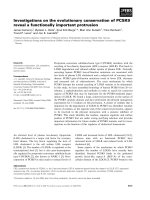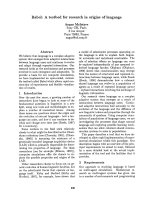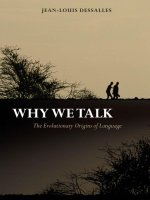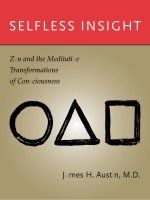- Trang chủ >>
- Khoa Học Tự Nhiên >>
- Vật lý
why we talk the evolutionary origins of language mar 2007
Bạn đang xem bản rút gọn của tài liệu. Xem và tải ngay bản đầy đủ của tài liệu tại đây (3.73 MB, 397 trang )
Why We Talk
Studies in the Evolution of Language
General Editors
Kathleen R. Gibson, University of Texas at Houston, and
James R. Hurford, University of Edinburgh
Published
1 The Orgins of Vowels Systems
Bart de Boer
2 The Transition to Language
Edited by Alison Wray
3 Language Evolution
Edited by Morten H. Christiansen and Simon Kirby
4 Language Origins
Evolutionary Perspectives
Edited by Maggie Tallerman
5 The Talking Ape
How Language Evolved
Robbins Burling
6 The Emergence of Speech
Pierre-Yves Oudeyer
translated by James R. Hurford
7 Why We Talk
The Evolutionary Origins of Language
Jean-Louis Dessalles
translated by James Grieve
In Preparation
The Evolution of Meaning
Language in the Light of Evolution I
James R. Hurford
The Origins of Linguistic Form
Language in the Light of Evolution II
James R. Hurford
Published in Association with the Series
Language Diversity
Daniel Nettle
Function, Selection, and Innateness
The Emergence of Language Universals
Simon Kirby
The Origins of Complex Language
An Inquiry into the Evolutionary Beginnings of Sentences, Syllables, and Truth
Andrew Carstairs McCarthy
Why We Talk
The Evolutionary Origins of Languag e
Jean-Louis Dessalles
translated by James Grieve
1
3
Great Clarendon Street, Oxford ox2 6dp
Oxford University Press is a department of the University of Oxford.
It furthers the University’s objective of excellence in research, scholarship,
and education by publishing worldwide in
Oxford New York
Auckland Cape Town Dar es Salaam Hong Kong Karachi Kuala Lumpur
Madrid Melbourne Mexico City Nairobi New Delhi Shanghai Taipei Toronto
With oYces in
Argentina Austria Brazil Chile Czech Republic France Greece
Guatemala Hungary Italy Japan Poland Portugal Singapore
South Korea Switzerland Thailand Turkey Ukraine Vietnam
Oxford is a registered trade mark of Oxford University Press
in the UK and in certain other countries
Published in the United States
by Oxford University Press Inc., New York
English translation ß James Grieve 2007
French edition, Aux origines du langage, first published by
Herme
`
s Science Publications
ß Herme
`
s Science Publications, Paris, 2000
Hermes Science Publications and Oxford University Press thank
the French Ministry of Culture for its assistance in the publication of the
French and the English editions of this work.
The moral rights of the author have been asserted
Database right Oxford University Press (maker)
First published 2007
This book has been published with the assistance of the
French Ministry of Culture (Centre national du livre).
All rights reserved. No part of this publication may be reproduced,
stored in a retrieval system, or transmitted, in any form or by any means,
without the prior permission in writing of Oxford University Press,
or as expressly permitted by law, or under terms agreed with the appropriate
reprographics rights organization. Enquiries concerning reproduction
outside the scope of the above should be sent to the Rights Department,
Oxford University Press, at the address above
You must not circulate this book in any other binding or cover
and you must impose the same condition on any acquirer
British Librar y Cataloguing in Publication Data
Data available
Library of Congress Cataloging in Publication Data
Data available
Typeset by SPI Publisher Services, Pondicherry, India
Printed in Great Britain on acid-free paper by
Biddles Ltd., King’s Lynn, Norfolk
ISBN: 978–0–19–927623–3
13579108642
Contents
Foreword ix
Part I
The place of language in human evolutionary history
1 Animal and human communication 3
1.1 The biological status of language 3
1.2 Animal communication 5
1.3 From signals to behaviour 8
1.4 Language as code 11
1.5 Communication in human primates 20
1.6 Use of language by humans 23
1.7 The originality of language 28
2 Culture, languages, and language 30
2.1 Why are there many languages? 30
2.2 The myth of the mothe r language 34
2.3 Language and the palaeolithic revolution 42
2.4 The equal complexity of languages 47
3 The biological roots of language 51
3.1 The organs of language 51
3.2 Neuronal circuitry dedicated to language 54
3.3 Language learning in animals 57
3.4 Does animal communication entail syntax? 63
3.5 Language learning and universals 66
3.6 Linguistic abilities in neonates 68
3.7 The deaf children of Nicaragua 70
3.8 Language is a compulsory activ ity 73
3.9 The faculty of language 76
4 Misapprehensions about the origins of language 77
4.1 That language was a necessary outcome of evolution 77
4.2 That evolution towards language was slow and gradual 80
4.3 That language was an outcome of intelligence 82
4.4 That in the beginning was the word 86
4.5 That language is a vestige of past evolution 88
5 Language as an evolutionary curiosity 92
5.1 Evolution’s di rectionless advance 92
5.2 Nature appears to jump 98
5.3 The role of macromutation in the emergence of language 100
5.4 Could language be the outcome of a quite different ability? 105
5.5 Dr Pangloss’s explanation of language 108
6 The local optimality of language 116
6.1 Between chance and necessity 116
6.2 The slow and the fast in evolutionary change 118
6.3 Macroevolution and microevolution in the emergence of language 129
6.4 What’s the point of communicating? 135
Part II
The functional anatomy of speech
7 Putting sounds together 139
7.1 The articulatory gestures of language 139
7.2 Was language gestural before it became oral? 142
7.3 The atoms of language: gestures or phonemes? 145
7.4 Phonological structuring of languages 150
7.5 Mental structures underlying the assemblies of sounds 153
7.6 The nature of the rules of language 157
7.7 The biological function of phonological ability 160
8 Protolanguage 165
8.1 Communicating just with words 165
8.2 A language that is not learned 168
8.3 Protosemantics 173
8.4 Prelanguage, a language without sentences 178
vi Contents
8.5 The lexicon of protolanguage 184
8.6 Protoconversations 190
9 The mechanics of syntax 194
9.1 The phenomenon of syntax 194
9.2 The importance of relations between words 197
9.3 Some facts about syntax 200
10 Syntax and mean ing 210
10.1 From protolanguage to language 210
10.2 Semantic recursion and syntactic recursion 214
10.3 The principle of semantic linking 216
10.4 The autonomy of syntactic mechanisms 220
10.5 Another form of syntax 222
10.6 The origin of syntax 229
11 The structure of meanings 232
11.1 Concepts, images, and definitions 233
11.2 Thematic segmentation 238
11.3 Double meanings 246
12 The emergence of meaning 251
12.1 The dissociation of the two forms of meaning 251
12.2 A functional role for thematic segmentation 256
12.3 The emergence of human meaning 262
Part III
The ethology of language
13 Conversation behaviour 268
13.1 An apparently unimportant behaviour 268
13.2 Some attempts to explain speech events 271
14 Language as information 281
14.1 The constraint of relevance in conversation 281
14.2 Relevance in the informative mode 283
14.3 Creatures responsive to informati on 289
14.4 The biological grounding of the informative mode 291
14.5 Instinctive sharing of information 292
Contents vii
15 The birth of argumentation 294
15.1 Relevance in the argumentative mode 294
15.2 The idea of cognitive conflict 299
15.3 The recursive nature of argumentation 301
15.4 The proximal function of language 307
15.5 The origin of conversational modes 312
16 Language as an evolutionary paradox 315
16.1 The theory of social bonding 315
16.2 The altru istic character of language 318
16.3 Language and cooperation 321
16.4 Language and cheating 325
16.5 The cost of communication 328
16.6 Three stages in the evolution of language 332
17 The political origins of language 336
17.1 How speakers benefit by being relevant 336
17.2 Prestige theory 341
17.3 The political role of language in hominids 344
17.4 Language as showing off 351
17.5 Homo loquens or Homo politicus 355
17.6 The other functions of language 357
18 Epilogue 360
18.1 A genesis in three stages 360
18.2 A new view of language 362
18.3 Future perspectives 364
References 367
Index 377
viii Contents
Foreword
The question of the origin of the human species is no longer a monopoly
of palaeontologists. Those who take an interest in the emergence, over
evolutionary time, of a feature of humanity as fundamental as language
cannot restrict themselves to the study of fossils. If we are to understand
why our ancestors became gifted with the power of speech, it is essential to
establish a cognitive model of language behaviour. In the light of such a
model, it becomes possible to track backwards from the structure to the
biological function, which in turn enables us to define the particular
conditions that made the biological function advantageous for the people
who possessed it.
There have been remarkable advances of late in the cognitive sciences.
Their most marked feature at the present time must be the fact that they
now canvass matters which were once tacitly seen as taboo. For instance,
emotions and consciousness can now be studied without overstepping the
bounds of research on cognition, which was impossible not many years
ago. The question of the phylogenetic origin of language is another of
these paradoxically novel areas of study.
The scientific study of mental phenomena is usually driven by the desire
to understand how human behaviours are produced and eschews any
consideration of magical things, whether the soul, psychic energy, or the
life force. The basic method is to analyse the structure of such behaviours
and to seek their determinants in the biology and learning abilities of
individuals. In the case of language, research focuses on analysis of
phonological structures, syntactical structures, and semantic structures,
as well as on the structures of the neuronal circuits which make language
possible. On the other hand, questions of function, in the sense of
biological function, are unusual in cognitive science, though they are
inseparable from the study of animal behaviour. Why should human
beings be seen as an exception? For we too are biological beings, the
outcome of an evolution. By and large, our behaviours are not qualitatively
different from those of our hunter-gatherer ancestors. They are
behaviours which, like those of animals, are possible only because they
can fulfil a biological function.
Language lies at the heart of the preoccupations of cognitive scientists.
Though the structure of language has been abundantly studied, the same
cannot be said of its function. This ignorance of ours in the area of
language function is especially regrettable because our way of communi-
cating so as to transmit ideas and judgements seems to be unique in
the realm of living creatures. Why do we have this ability and other species
do not?
I am convinced that, if we systematically apply evolutionary insights to
cognitive science, we can thoroughly transform our understanding of
human beings. The evolutionary approach, by linking some structural
features of language to the necessity of a biological function, is a way of
reducing the apparent complexity of living phenomena and often of
bringing coherence to things from which it is absent. One of the questions
that this book is going to attempt to address directly is: What biological
necessity is there for language?
The scientific community is reintroducing phylogeny into the study of
cognition. By way of a contribution to this paradigm shift, I had the
opportunity to organize the Third International Conference on the
Evolution of Language, held in Paris in the year 2000. I am convinced
that the coming together of evolutionary biology and the cognitive
sciences, which once seemed so untoward to people working in fields
which they had seen for years as totally disparate, will prove to be lasting.
The main aim of this book is to contribute to that coming together and to
show how fruitful it may be.
A fair number of the ideas developed in this book were shaped during
discussions with participants in earlier conferences on the evolution of
language. I am very grateful to Chris Knight and Jim Hurford for their
belief in me and for having enabled me to have close contact with people
working in this area.
For their valuable assistance and support, I give special thanks to
Jean-Bernard Auriol, Olivier Hudry, Philippe Monnier, and Franc¸ois
Yvon, as well as to Laleh Ghadakpour who helped me develop some of
the ideas I present here. I have tried to heed their advice in ways which
I hope improve the quality and coherence of my arguments. I am
particularly grateful to Eric Bonabeau, one of the first scholars who
x Foreword
expressed confidence in my work and who made the initial suggestion that
I should write this book. I am glad to take this opportunity of expressing
my gratitude for the rigorous accuracy of my translator James Grieve. His
shrewd and uncompromising habits of work have enabled me to clarify a
fair few obscurities in my original French text. Writing on a subject which
has fascinated me for years also gives me the chance to thank my parents,
Robert Dessalles, who first explained the principles of evolution to me
when I was a child, and Fernande Dessalles who gave me advice and
encouragement during my work on the book.
My objective is to give a coherent and reasoned account of the
conditions out of which language grew. Readers will encounter a number
of original ideas which I hope will stimulate their spirit of enquiry.
Jean-Louis DESSALLES
Foreword xi
This page intentionally left blank
Part I
The place of language in human evolutionary
history
Introduction to Part I
To reconstruct the circumstances which may have led to the emergence of
language in the evolution of our ancestors, we can set about it in three
stages. First we can put language behaviour into the broader context of the
evolution of species. Then we can analyse the structure of language so as to
link it to a biological function. Thirdly, we can identify the conditions
which may have made such a biological function advantageous. These are
the themes of the three parts of the book, each of which contains surprises.
Language will come to seem more like a haphazard quirk of our develop-
ment rather than a necessary outcome. We shall see how its structure
suggests the existence of at least two quite separate stages in its evolution.
We shall also have to overcome the paradox that language seems prima
facie to be disadvantageous for those who use it. The book is designed as a
progression: my aim in Part I is to pose the problem; Part II analyses the
reasons underlying the functional components of language; and Part III
suggests a coherent explanation. A reader who wishes to grasp the logic of
this progression should follow the order of the chapters as presented.
A commonly accepted idea is that language is not just natural and self-
evident, but necessary. How could there be such a thing as intelligent
beings without speech? On this view, language, with all its biological
predispositioning, is the inevitable outcome of an evolutionary process
which starts with the amoeba and ends with human beings. This implies
that language is a behaviour which resembles other systems of communi-
cation used by animals but just happens to be more elaborate. The fact that
other species of animals do not ‘speak’ as well as we do means only
that their evolution is incomplete, that they have fallen by the wayside in
the advance towards the intelligence and culture which enable us humans
to share not only our resources but our thoughts. According to this view of
things, language is a marvellous asset which has given our species domin-
ion over the natural world. Does anyone need another justiWcation? The
usefulness of language can be taken for granted.
The aim of this Wrst part is to show that language cannot in fact be taken
for granted.
2 Language in human evolutionary history
1 Animal and human communication
Some take the view that language is merely a particular instance of animal
communication, whereas others see it as a behaviour which sets us apart
from animals. If we are to understand the process which endowed our
forebears with the ability to speak, this matter of our separateness or lack
of separateness must be faced at the outset. Does the advent of commu-
nication through speech constitute an unlikely innovation or should it be
seen as only a quantitative improvement on existing systems?
1.1 The biological status of language
The status of human language is a subject of controversy. Advances in
ethology have revealed the hitherto unsuspected wealth of animals’ modes
of communication. Could it be that human communication is only one of
these, a more complex extension but basically identical in its principle,
after the manner of present-day computers which, despite diVerences in
appearance, still function pretty much as computers did in the 1940s? If
we can answer no to that question, if human language is something
radically novel, quite unknown in the world of animals, then we must
explain how and why it came into being .
There is, of course, something inherently dubious about that second
possibility. If ever there was a prejudice that has hindered the advance-
ment of knowledge, it is the idea that the human race is separate from the
rest of the natural world, ruled by diVerent laws, and seen as a culmin-
ation. Even when nineteenth-century scientists Wrst abandoned the view
that humanity was the straightforward outcome of a divine plan, this did
not lead them to see our species as a mere haphazard result of evolution.
They found it diYcult enough to think of human existence as not being
necessary, as being nothing more than a contingent product of an
accumulation of chance events. Could it not at least be acknowledged that
our intelligence and culture set us apart from nature? Even primitive
human societies are subject to laws of their own making. If the human
can diVer to such an extent from the natural, then we surely must occupy a
place that is special and unique. According to that way of seeing things,
human evolution did follow a diVerent path which distanced us once and
for all from the animal realm. The existence of a culture then meant we
had to develop new faculties unrelated to our animal substratum, of which
language is the archetype.
In scientiWc circles which are informed about evolution and conversant
with examples of elaborate animal behaviours, it has become customary,
by way of reaction against such an anthropocentric view, to adopt a
radically continuistic position: humans being merely animals like other
animals, their characteristics are natural and grounded in their biology,
and any diVerences between their capacities and those of animals can only
be quantitative.
1
Saltation is foreign to nature, whether between chim-
panzees and humans or the donkey and the horse. This would make
human language a system of communication like any other; and any
appearance it mig ht have of being much more elaborate than animals’
modes of communication can be put down to our ignorance of these.
It is true that advances in ethology have made us rethink many a
preconceived notion about the originality of our own species. Since the
days when Descartes wondered whether animals were mere mechanical
automata, we have learned that they can make tools, learn elaborate
strategies, feel emotions that are akin to ours, form alliances, perceive
colours beyond our ken, build complex structures, and even construct a
culture (Bonner 1980; Wrangham et al. 1994). They can also convey their
mental states, tell lies, and communicate about objects that are absent.
What else can human beings do? Even laughter or smiling appear to be
aptitudes we share with the great apes (Goodall 1971: 243).
In any proper assessment of the originality of humans’ mode of com-
munication, it is important not to underestimate the complexity of animal
communication. Only a comparison can tell us whether this or that aspect
of human language is genuinely original and whether it distinguishes us
1
‘[T]he mental faculties of man and the lower animals do not diVer in kind, although
immensely in degree. A diVerence in degree, however great, does not justify us in placing
man in a distinct kingdom’ (Darwin 1871).
4 Why We Talk
from other species in the way that having a trunk distinguishes elephants
from the other ungulates.
1.2 Animal communication
All living beings communicate with other individuals of their own species.
Communication begins with the search for a mate. Without communica-
tion, transmission of genes is impossible; so, by the same token, would
be the existence of species. Communication exists also inside the body:
our cells have modes of communication which are gradually coming
to light. The cells in our immune systems, for instance, recognize each
other and can recruit other cells to help defend us against invasion by
an antigen. Such phenomena function via a system of transmission of
information which in some ways resembles language. For example, our
lymphocytes (white corpuscles) recognize the cells of our own body from
certain molecules on their surface; when these markers are absent, the
lymphocytes produce secretions which alert other cells in the immune
system.
All this seems very remote from human language. These signals trans-
mitted between microscopic elements of our physiology are in fact just
that, signals. Language enables us to communicate emotions and abstract
thought and to convey concrete information about the exact position of
things which are absent. It was once believed that the second of these two
abilities was restricted to human beings or to a few species among the
primates. In the 1940s, everyone was taken by surprise when Karl von
Frisch published his observations on the ‘language’ of bees. It had been
known for a long time that honey bees (Apis mellifera) had the ability to
inform other females in their hive of the location of a source of food. What
was unknown, though, was that they used a precise code to convey the
information. Von Frisch, by altering the positions of his lures and observ-
ing the behaviour of the bees when they returned to the hive, contrived to
decipher the famous ‘dance’ of the bees, which must perforce be consid-
ered to be a genuine code (von Frisch 1967).
Another example of animal communication which is also frequently
cited and has been closely studied is the alarm calls of vervets (also known
as green or grass monkeys). These small monkeys have a varied range of
cries which they use for warning of the approach of a predator or the
Animal and human communication 5
presence of individuals from another troop. The meanings of these alarm
calls are very precise, as has been demonstrated in experiments using
recordings of them. When indiv idual monkeys hear a recording of the
cry indicating the approach of a predator, the reaction they have varies
with the warning: if it concerns an eagle, they take cover; if it concerns a
snake, they straighten up and scan the grass round about; if it is a leopard
warning, they take to the trees. It was thought for a long time that these
calls expressed no more than an emotional state, that they were an
eVect rather than the cause of the animals’ taking Xight. Experiments
with recorded calls show that this is not the case and that the calls are
genuine signals (Cheney and Seyfarth 1988). Knowledge of the acoustical
structure of the signals is genetically programmed in the monkeys. The
approximate meaning of the calls is also genetically programmed, though
young monkeys have to learn to get them exactly right; until they are
two or three years of age, their alarm cries give warning about species
which constitute no danger. For example, the alarm cry that the adult
monkeys use mainly for the martial eagle is usually stimulated in the
immature monkeys by the arrival of a vulture, which is not a predator
(Hauser 1996: 307).
Ethologists have examined the question whether the vervets’ vocal
signals are in some measure tantamount to words. Any behaviourist
psychologist who decided to apply to them the conditioning principle
established by Pavlov’s well-known experiment would have no diYculty in
isolating a simple association of stimuli: once the acoustical stimulus had
become systematically associated with the stimulus of the sight of the
predator, it would be suYcient to set oV the appropriate Xight reaction. In
such a directly linked association of stimulus and response, there is no role
for any mental state representing the meaning of the situation suggested
by the alarm call. If this is so, the vocalizations of the monkeys could
hardly be seen as embryonic language. As it happens, in this case the
behaviourist interpretation is mistaken. Through a series of well-designed
experiments, Cheney and Seyfarth have shown that the association
between the acoustical forms and the behavioural responses was not direct
but that it must be mediated by a form of mental representation. They did
this by using a habituation test, designed to diminish the intensity of the
behavioural responses by repeated exposure to the stimuli. There comes a
time when, having repeatedly heard the same recording of a particular call,
the monkeys ignore the message and no longer react to it. In that state,
6 Why We Talk
if they hear a quite diVerent signal their reaction is the appropriate one.
Habituation is therefore selective. Cheney and Seyfarth’s investigation was
designed to Wnd out whether habituation could be transferred to neigh-
bouring acoustical forms, or to signals close in meaning. An example from
the Weld of language can be seen in the fact that we can easily associate a
word like fraction with numerator and are not limited to associations based
on resemblances of form such as fraction and traction. The latter pair of
words are very close phonetically but they do not usually suggest any
closeness of situations, whereas the Wrst pair are often associated in the
same context. In such cases, we are sensitive to associations between
meanings rather than to phonetic resemblances. So, how do our vervet
monkeys perform?
To determine whether the monkeys compare signals in terms of their
acoustics, as the conditioning theory would suggest, or in terms of their
meaning, Cheney and Seyfarth used recordings of two calls produced
during territorial disputes with neighbouring troops: one of these cries
was a kind of trill sounding like wrr and the other a sharper one that
sounded rather like chutter. The Wrst one is uttered when individuals
notice the presence of another troop; the second one is used when the
two troops begin to threaten each other or actually start to Wg ht. The
interest of these two sounds is that, though phonetically dissimilar, their
meanings are quite close. The experiment shows that monkeys who have
been habituated to hearing recordings of wrr repeated every twenty
minutes barely react when they hear a recording of chutter produced by
the same individual. However, their reaction is normal if the habituation
signal and the test signal have ver y diVerent meanings, for instance the
leopard alarm call and the eagle alarm call. Nor is habituation transferred
when the test signal is uttered by another monkey. This leads the authors
to the conclusion that signals uttered by the monkeys entail mental
representations and that it is these representations which underlie the
behaviour. If the link between the signals and the behaviours were direct,
acoustical similarity is what would be stressed by the habituation test. In
fact, the similarity in question is one requiring a mental construction
which takes account of the sender of the message and the situation it
suggests. For this reason, communication among vervets has some simi-
larity with communication among human beings. And it is that similarity
that we are about to set out in detail.
Animal and human communication 7
1.3 From signals to behaviour
One way of marking oV human language from animal communication is
to present the latter as a reXex behaviour and to maintain that acts of
animal communication are directly linked to the behaviour they provoke
in the receiver. Before the experimentation by Cheney and Seyfarth, it was
possible to see the Xeeing of vervet monkeys as an immediate and reXex
consequence of the alarm call. If that were the case, one could reduce the
eVect of the signal to the behaviour that it provokes.
Such a description of animal communication, once favoured by behav-
iourist psychologists uninformed about the real behaviour of animals in
their natural habitat, often turns out to be simplistic. Two successive
mechanisms can intervene between a signal and any behavioural response.
The Wrst of these is a representational mechanism. The signal is used to
construct a mental representation and it is that representation which sets
oV the behaviour. As we have seen, the experiments by Cheney and
Seyfarth argue in favour of seeing this type of representation in vervets,
for the animals’ associations with the signals relate to the situations to
which they belong rather than to their acoustical form. This is why we can
posit that the immediate eVect of the communication act is the making of
a mental representation. If that is the case, then the eVect of one of these
monkeys giving the call usually associated with the presence of a leopard
will be to call to the minds of all its fellows something like the image of a
leopard, deriving from the memory of actual situations. Experimental
data tend to support this view; but they come nowhere near to proving
that the mental representation summoned up by the alarm call is as
concrete as that.
What would be the point of a mental representation that intervenes
between a signal and a behavioural response? The obvious disadvantage is
a slower reaction. Instead of reacting immediately to the signal, in a reXex
way, the animal reconstructs a representation of the situation with which
the signal is habitually associated. Then it reacts to a comparison between
its representation and the present situation. Extrapolating a little from the
experimentation by Cheney and Seyfarth, we can say that when the
monkey hears the cry indicating the approach of another troop, it
makes a representation of them which it projects onto the present situ-
ation. This explains why the monkey does not react to hearing another call
8 Why We Talk
that belongs to the same situation, even if the other call is acoustically
diVerent. What could be the point of going through this sort of com-
plicated mechanism in order to produce an appropriate behavioural
response? The advantage of such an intermediate procedure lies in the
possibility of taking account of the context. A monkey which hears the
cry associated with snakes looks at the ground in its vicinity, so as to
localize the danger; it does not dash away as it would if its Xight behaviour
was a reXex. It imagines a snake and looks for one in the context of its
actual situation; and if the context gives no reason for assuming that a
snake is nearby, the monkey may not Xee needlessly.
The construction of a mental representation of the situation indicated is
not the only mechanism that may separate the signal from the behaviour it
is supposed to bring about. In many cases, the existence of a mental
representation can be useful if it leads to an assessment. If the animal
hearing the signal is capable of assessing some aspects of the utterance,
then it is not a mere slave of whatever it may have perceived. In particular,
thanks to the mechanism of assessment, it can resist being manipulated by
the animal uttering the signal. For example, though the precise biological
function of territorial birdsong remains in part a mystery, it has been
established that females are sensitive to some aspects of the singing of
males of their species. The onset of pre-breeding behaviour in female song
sparrows, for instance, happens more readily when the songs they can hear
are marked by certain characteristics, such as the richness of the repertory
(sparrows can produce between Wve and thirteen types of song) and the
contrast between the immediate repetition of a song and its delayed
repetition (Hauser 1996: 396). It is clear that the female brings an assess-
ment to bear on what she hears, though the grounds of this assessment
and its biological meaning are still partly unknown to us.
Assessment may function on the basis of the signal itself, as one
supposes is the case with territorial birds, or else through the representa-
tion that the signal gives rise to. A monkey which checks the state of its
surroundings before Xeeing or not Xeeing bases its decision on its repre-
sentation of the situation. Its behaviour is not an automatic result of the
representation it has structured from the alarm call and the context. It
appraises the representation; and what determines the choice of proper
behaviour is the outcome of this appraisal. Assessment is sensitive to
factors such as experience or habituation; and in addition it may integrate
contextual factors such as the credibility of the source of the signal. In the
Animal and human communication 9
habituation experiments, the monkey went back to paying normal atten-
tion when the alarm calls to which it had been habituated star ted coming
from a diVerent source (Cheney and Seyfarth 1990).
The clearest case of appraisal of a communication situation is where
there exists a threat. It is in the interest of an individual under threat to
gauge as accurately as possible the real intentions of an attacker; and it does
this by attending to the signals uttered by the latter. According to the theory
of John Krebs and Richard Dawkins, this assessment is rendered necessary
and complex because of the risk of manipulation (Krebs and Dawkins
1984). A dog threatens by baring its teeth and crouching in a way that
suggests it is about to leap at its opponent. But is that really its intention?
The objective of such a very visible show may actually be to avoid the act of
aggression with its attendant risks. If the individual under threat is not to
be manipulated, it must make a plausible evaluation of the likelihood of
being attacked. Krebs and Dawkins posit a kind of evolutionary one-
upmanship, since in each of the competing roles opposite interests are at
stake. This leads to signalling which is more and more diYcult to gauge and
to evaluative abilities which are more and more sophisticated.
Some behaviours presuppose cognitive abilities intermediate between
reXex and reXexion (Grumbach 1994) and cannot be reduced to a mere
coupling of associations of the stimulus–response variety. This can be seen
in communication within many species. In some of them, the perceiving
of a signal leads to a mental representation which, one may suppose, is an
approximate reproduction of a direct perception of the event indicated.
The ensuing behaviour is thus, in such cases, more closely linked to the
situation indicated by the signal than to the signal itself. The second
mechanism that we have mentioned consists of an assessment of the signal
or of the representation it brings to mind. The existence of such mechan-
isms gives an inkling of the elaborate mental processes required by animal
communication, which go well beyond mere associations, whether genetic-
ally programmed or learned. This is why animal communication without
a doubt resembles human communication. Words spoken by someone
make us summon up mental representations which we evaluate. When we
hear on the weather forecast the words A southerly depression is on the way,
we Wrst construct a representation of the situation, then we assess the
unpleasant consequences it will involve for the weekend. Prima facie, this
does not seem all that diV erent from what a vervet monkey does when it
10 Why We Talk
hears an alarm call, then decides to Xee in a particular way and with
particular urgency.
1.4 Language as code
Discovering a quality which distinguishes language from systems of ani-
mal communication seems easy. One of the most striking characteristics
of human language is its referential power: words stand for entities. The
name Peter can stand for a particular person, even in his absence. So
language can be seen as a code: we translate a situation into words for an
interlocutor, who decodes the message and reconstructs the situation
which motivated the act of communication. One of the reasons for the
interest aroused by von Frisch’s experiments with bees is that they make it
impossible to see human language as in any way superior just because it
can encode references to absent entities.
Bees’ words
Inside the hive, as a bee clambers about the suspended frames in the dark,
she does a sort of dance. She advances a short distance in a straight line,
waggling her abdomen about Wfteen times per second. She then goes back
to her starting point, walking normally, but following a semi-circular
path. She repeats this cycle, alternating her semi-circles to left and right.
The whole dance eventually forms a rough Wgure of eight, by means of
which she manages to convey the position of a source of food.
The most impor tant element in the dance is the central straight line of
the Wgure of eight, where she is walking and waggling her abdomen. The
nearest of the bees that follow her about pick up her movements from the
faint sounds and the breeze she makes during her dance. The speed and
the number of abdomen waggles indicate the distance between the hive
and the source of food: the nearer the food, the quicker the dance. A three-
second burst, for example, indicates a distance of 500 metres. What is
most spectacular is the encoding of direction, as elucidated by von Frisch:
the angle between vertical and the direction taken by the bee as she walks
her straight line reproduces the angle between the direction of the sun and
the direction to follow to locate the food. Bearing in mind that a bee with a
message to deliver may dance for about an hour, one realizes that she must
Animal and human communication 11
incorporate into her dance a gradual correction to allow for the change
in the angle of the sun. The existence of the code has been proved by
biologists using miniature robots to ‘talk’ to bees (Kirchner and Towne
1994; Michelsen 1998).
The properties of this bee language are interesting in more ways than
one. Despite weighing less than a gram, these creatures can make reference
to an entity that is absent (though it should be noted that the bee does pass
on to her fellow workers samples of the source of food she is indicating).
The reference to the source of food consists of several complementary
codes, notably one for the direction to take and one for the distance to
cover. These codes are analogue codes, in that the bees can indicate
adjacent locations by dances which are very close to one another. They
are none the less codes, given that they entail the representation (re-
presentation) of a particular Weld, in this case a pair of spatial coordinates,
via a diVerent Weld. That is, the few centimetres traversed on the frames of
wax represents a distance of several tens or even hundreds of metres
outside the hive; the vertical direction represents the direction of the
sun; the direction of the central straight line represents the direction to
follow. What is so striking about such communication is the use of a Weld,
the bee’s movements, to represent a diVerent Weld, spatial locations. All
this would be far less interesting if the bee merely guided the others by
Xying oV towards her Wnd.
However, the ‘language’ of bees does diVer in several ways from our
idea of our own mode of communication. One of the essential diVerences
lies in the Wxed and genetically programmed character of the dance. All
the bees of any given species dance and interpret the dance in exactly the
same way. There is no need for them to learn anything; the behaviour is
coded into their genes. The dancing is rather like Wlling in a form; it
leaves no scope for inventiveness; everything that can be expressed is
already laid down, the distance, the direction, and the quality of the food
discovered. How diVerent from human communication, in which our
freedom seems almost boundless! This freedom may well be, in some
measure, illusory (cf. Chapter 14); but it is undeniable if we compare
ourselves to bees. Our words and sentences seem inWnitely more variable
than the patterns outlined by the insect on the frames of the hive.
Our freedom comes from the fact that the signs we use are arbitrary
conventions.
12 Why We Talk









